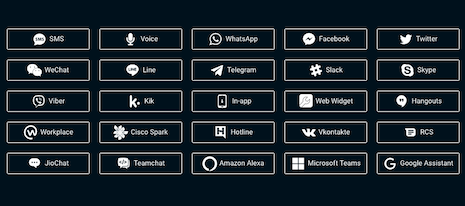Can Facebook recuperate from 2018 chaos?
Advertisers and users have installing issues about Facebook.
 New face of messaging: WhatsApp stickers. Image credit: WhatsApp
New face of messaging: WhatsApp stickers. Image credit: WhatsApp
By Beerud Sheth
As 2018 draws to a close, it is a good time to take stock of the year in the world of messaging and conversational experiences.
Unlike prior years, this one is characterized by less hype and more progress.
Developers have been quietly working away, far from the madding crowd, as messaging volumes grow massively and conversational experiences continue to pervade every aspect of human existence.
Getting the message across
Over the last few years, mobile messaging usage has exploded. It now dominates smartphone usage.
While consumer communication grew rapidly a few years ago, the more recent and interesting phenomenon is the rise of “messaging as a platform” – a platform for developers and marketers to engage their customers and build advanced conversational experiences.
Messaging and conversational experiences are gradually transforming every aspect of the human-computer interface.
Facebook Messenger, which launched its bot API with great fanfare in 2016, is now coming of age. Facebook this year disclosed that more than 300,000 chatbots were developed on its platform.
Messenger has by far the most technically advanced APIs, tools and platforms for chatbot developers. It also offers open access to all developers and does not charge a messaging fee. Therefore, it is often the first channel that developers experiment with, even if the bot is ultimately deployed on another channel.
 Cheat chat: Many platforms of messaging. Image credit: Gupshup
Cheat chat: Many platforms of messaging. Image credit: Gupshup
In another major new development this year, Facebook-owned WhatsApp launched its “WhatsApp for Business” platform – an API for enterprises to send automated messages to consumers.
In most parts of the world, except United States and East Asia, WhatsApp is the dominant messaging channel. The frequency and intensity of WhatsApp usage dwarfs any other communication channel in those countries.
While that has only been the case for consumer-messaging so far, the new APIs will now attract enterprise-messaging volumes.
Marketer usage is expected to grow as WhatsApp adds more features, expands developer access and fine-tunes its pricing and policies.
RCS, the successor to SMS, continued its slow progress this year.
Wireless carriers in Japan went live with a joint RCS service, making it the first country with full RCS coverage. It will be interesting to see which channel enterprises and consumers prefer, as RCS and Line battle for messaging volumes in Japan.
In all likelihood, they will both grow, as there is immense potential for additional use cases to migrate from applications to messaging.
In the U.S. this year, AT&T went live with RCS, while Verizon enabled it on a few devices.
Worldwide, as other operators continue to look at RCS, the deployment timelines are either less clear or very long.
Handset manufacturers are slowly starting to enable RCS on their devices. However, the “elephant in the room” is what will Apple do – its position remains unclear.
Finding its voice
Meanwhile, Amazon’s Alexa, the leader in voice-based conversational services, continues its march through the kitchens and living rooms of consumers.
In 2018, Amazon introduced many different form factors combining audio speakers and screen-based interfaces. Additionally, it also offers cloud APIs for others to embed Alexa into their devices.
At the same time, Google Assistant is marching onto Android smartphones worldwide, with support announced in 2018 for 30 languages in 80 countries.
The rise of Alexa and Assistant shows that, depending on context, users will seamlessly use both oral and textual conversations to get things done.
For example, in private spaces with busy hands – e.g. when driving or cooking – audio is the preferred conversational medium. However, in public spaces – e.g. meeting room or noisy street – screen-based textual or visual interaction is usually the preferred mode.
Even as other channels mount a bid to be viable alternatives, SMS continues to remain the preferred channel for enterprise messaging, given its ubiquity.
Globally, marketers send 2 trillion text messages to consumers worldwide. These are mostly transactional messages notifying customers about information related to their transaction.
This year messaging global volume grew by about 10 percent, according to market research firm Mobilesquared, which is not bad, given its massive scale.
While SMS does have limitations such as plaintext, restricted-length format, it more than makes up for it with its reach and ubiquity.
Other services thrive as well, with varying degrees of success.
Telegram continues its standoff with Russian regulators who want access to its encryption keys.
Viber launched new features enabling massively large communities along with monetization tools for moderators.
While other channels continue to develop, the gold standard worldwide for rich messaging functionality remains WeChat, along with similar apps Line and Kakao.
These messaging apps enable users not just to communicate but also do a wide variety of transactions, including shopping, banking, insurance, payments, travel, taxis, food delivery, jobs, music and news. They have now become super-apps that subsume many other apps within them.
Indeed, these are powerful illustrations of the vision of “messaging as a platform.”
MESSAGING CHANNELS and conversational experiences continue their rapid growth even as the hype cycle has moved on.
As they say, it is easy to overestimate the short-term and underestimate the long-term. That is certainly the case with messaging and conversational experiences.
As messaging functionality and AI/NLP capabilities reach an inflection point, it is advisable not to underestimate 2019.
 Beerud Sheth is founder/CEO of Gupshup
Beerud Sheth is founder/CEO of Gupshup
Beerud Sheth is founder/CEO of Gupshup, San Francisco. Reach him at beerud@gupshup.io.
Consumer adoption of “IoT” developments in the house is accelerating. Image credit: Printemps
A growing variety of merchants see the power of utilizing the Internet of Things, particularly as a method to enhance store operations and stock management.
According to a brand-new report from Retail Systems Research, 69 percent of merchants believe IoT will substantially modify the method they run, up from 53 percent in 2017. The interconnectivity of devices from clever gadgets and vehicles and trucks to house gadgets and more is currently having an impact on customers every day lives.
” Its as though the buzz of IoT is coming relates directly to this will conserve my service in new and fantastic techniques prior to the required diligence to comprehend what these tools can do, or what is needed on the part of organisation to make the most of them effectively,” mentioned Steve Rowen, managing partner at RSR and coauthor of the report.
The repot is based upon a research study of 116 sellers.
IoT innovationsTechnology and ecommerce continue to present merchants with brand-new troubles and opportunities, nevertheless the focus should stay on traditional residents of the organisation: handling stock, improving customer relations and making stores more shopper-friendly.
As brand names leading concerns differ extensively, not all business comprehend how operations will change with more IoT mix. Twenty-seven percent of individuals acknowledge they do not understand the functional result that IoT will have, an increase from 18 percent the previous year.
Business have different IoT job issues. Image credit: RSR
The leading business are influenced by having more precise stock information to serve their multichannel sales, while business that saw weaker sales were driven by the chance to make internal operations more efficient. Retail winners also focused on finding new methods to contact customers, while the rest were more thinking about finding approaches to cut expenditures.
While all business are wanting to boost stock management and ward off competitors to different levels, the common denominator is that the best-performing business concentrate on consumer-focused IoT tasks while the rest purchase tasks that have a quicker internal result.
TechAs and sellers is true with IoT, high-end trademark name should concentrate on getting the fundamentals of innovation right prior to handling the flashier digital functions.
At a panel hosted by Gartner L2, Astound Commerce, Fluid and CoreMedia, speakers went over a few of the difficulties and possibilities dealing with design and charm trademark name as they aim to acquire omnichannel retail, from breaking down organizational silos to handling the changing face of client engagement. While brand may need to choose and select what they can do based upon budget, staffing or putting restraints, the consumer should be at the heart of these choices (see story).
Initially established to confirm offers utilizing digital currencies, blockchain is now being used for numerous applications throughout a variety of markets. According to Fashionbis” Blockchain in Fashion and Retail Industry” report, huge business can utilize blockchain development to follow the whole product cycle, from production to even product use.
Blockchain works as a decentralized database, permissioned blockchains use extra security so users can manage supply chain management and other tasks (see story).
” Confirmation of credibility, location throughout every stage of the supply chain, direct exposure for the functions of conference customer require– these are incredibly effective tools that assist deal with the problems high-end trademark name have really been so challenged by for so long,” RSRs Mr. Rowen mentioned. “Most who have really effectively carried out these tools are staying actually tight-lipped about it, and naturally so.”
IoT can be leveraged to manage stock. Image credit: Nordstrom
IoT adoption and apprehension similarly differs throughout market sectors. Merchants of clothes and tough items have the clearest concept on the repercussions that IoT will have, as a minimum of 80 percent of participants think they have some concept of future adjustments.
RSR took a more detailed have a look at how “retail winners”– organisation that saw sales development of more than 4.5 percent– were approaching the subject.
According to a brand-new report from Retail Systems Research, 69 percent of merchants believe IoT will substantially modify the method they run, up from 53 percent in 2017. Its as though the buzz of IoT is coming relates directly to this will conserve my service in new and fantastic approaches prior to the required diligence to comprehend what these tools can do, or what is needed on the part of company to take benefit of them effectively,” specified Steve Rowen, managing partner at RSR and coauthor of the report.
Confirmation of credibility, location throughout every stage of the supply chain, direct exposure for the functions of conference customer require– these are extremely effective tools that assist fix the concerns high-end brand name names have really been so challenged by for so long,” RSRs Mr. Rowen mentioned. “Most who have in fact effectively executed these tools are staying actually tight-lipped about it, and naturally so.”